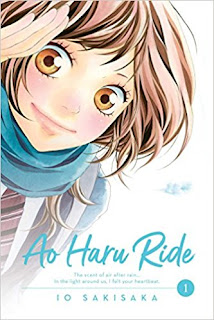The story is nearly beat-for-beat what we got in the anime. While the anime is very well drawn, the art here is exceptional. The expressiveness of characters, the uniqueness of each of their designs, the attention to detail, the complex use of screen tones, the mature and realistic style all work to support an emotionally nuanced story with a very likable but never perfect lead heroine.
Our story starts in middle school where Futaba Yoshioka finds herself drawn to the slim and slightly short Kou Tanaka. He is at times quiet, other times expressive, with deeply penetrating eyes. They connect and finally admit their feelings for each other. A plan is made to meet for the festival, but Kou never shows. Flash forward to highshool and suddenly Futaba bumps into him out of nowhere. Is this really him? He has a different name and Kou was supposed to have moved away years ago. His personality seems a bit off as well. He's cold and sarcastic, not sweet and sensitive like before, but this new Kou can't quite seem to distance himself from Futaba completely.
In four chapters, Sakisaka-sensei manages to craft a richly detailed character in Futaba. At first she seems a bit aloof/infatuated with how others perceive her. She is clearly attractive, but also bears the emotional scars from being bullied in late middle school by jealous girls. She works hard to set out on a new path only to realize that she wasn't being true to herself.
Showing greater depth than we might have expected at first, Futaba is empathetic to others, particularly another girl getting bullied in her current class, and outspoken for herself when she needs to be. She's also not afraid to challenge Kou, if that really is him. When comparing how little we learn about the personhood of the female lead in another series I'm currently reading, even after three volumes, it truly is amazing what Sakisaka-sensei does to define Futaba so completely and compellingly in just one volume.
Kou too has depth. We see him at multiple ages, also with his older brother, his friends, and with Futaba. He is consistently inconsistent, or perhaps better described as fighting with himself. It's hard to talk about here because I know more from the anime, but it again goes to Sakisaka-sensei's strength in characterization that we want to know so much more even with all that she's given us to start with.
The story is a realistic one. There aren't crazy setups and plot for the sake of plot. In fact, nothing much happens in four chapters. We spend our time getting to know people. Even when Futaba confronts her current so-called-friends, it isn't an epic drama. This is a thoughtful, and somewhat low-key story buoyed by crisp art and deep characters.
It's hard to think of what would make this volume better. We have the classic setup of a boy and girl at odds who are clearly destined to be together. It is realistically told, rather than played for comedy or drama. It is subtle and beautiful. This could be the start of a modern and timeless classic. 9/10 for Ao Haru Ride volume 1! This is shoujo manga at its finest.
✩🚺


No comments:
Post a Comment
Remember: please talk about the work, and offer counter points to others' analyses but DO NOT ATTACK THE PERSON whose analysis you are countering. (no ad hominem comments) Thanks! <3